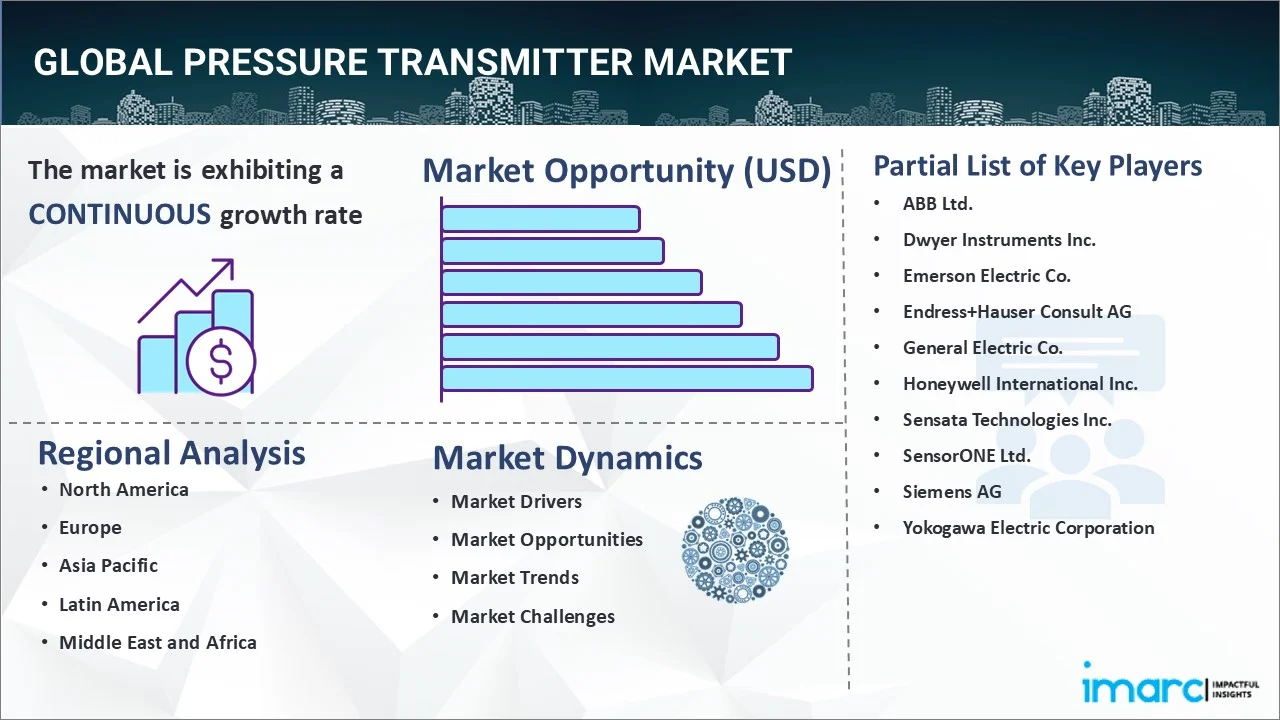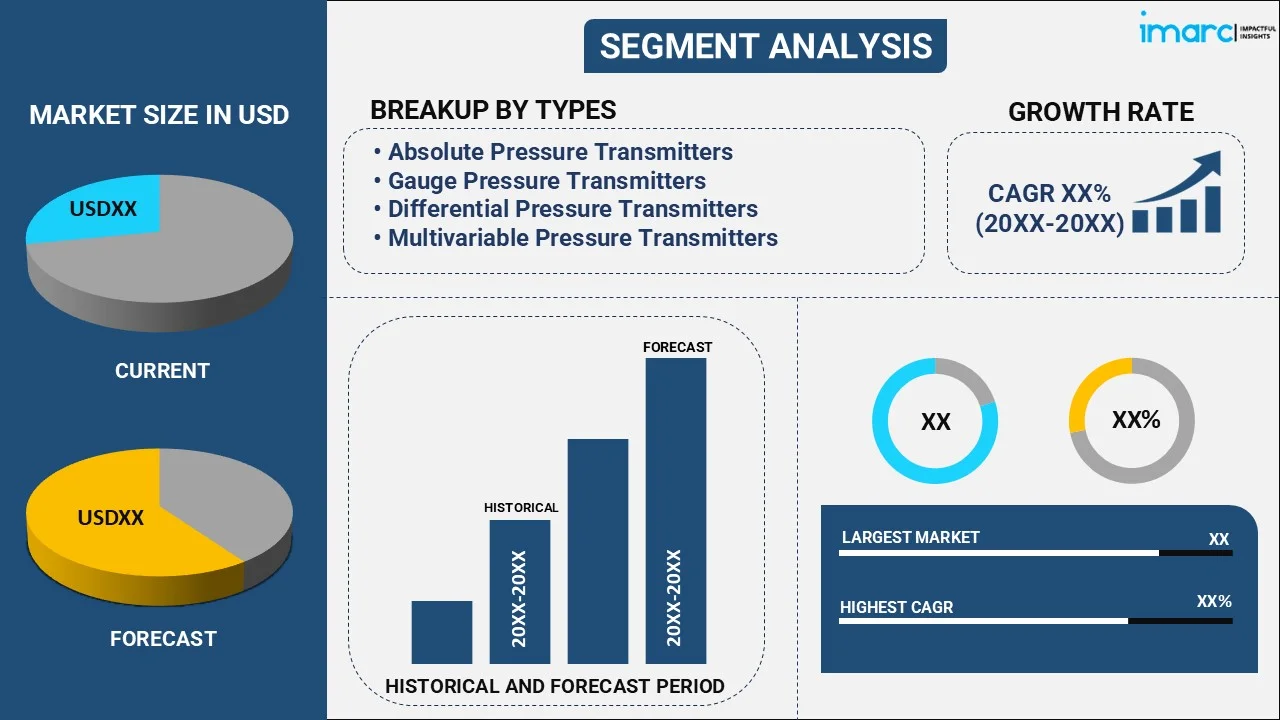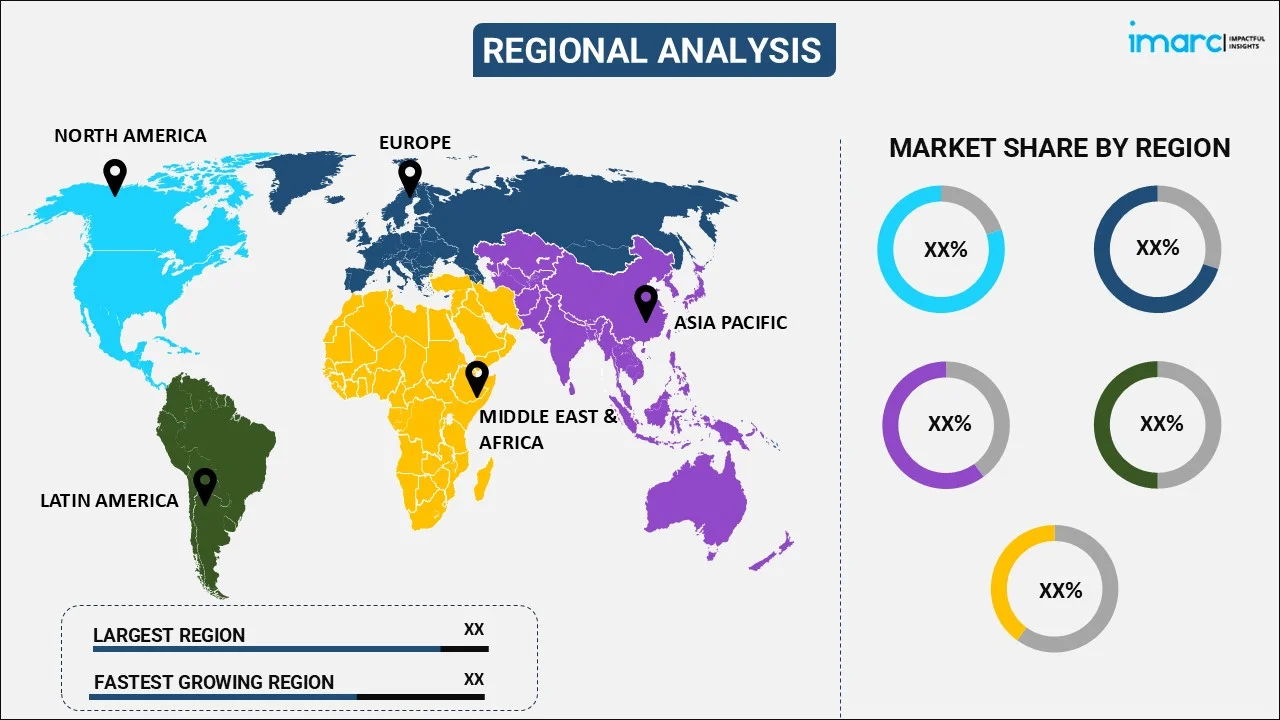
Pressure Transmitter Market Report by Type (Absolute Pressure Transmitters, Gauge Pressure Transmitters, Differential Pressure Transmitters, Multivariable Pressure Transmitters), Sensing Technology (Strain Gauge, Capacitive, Piezoelectric, and Others), Fluid Type (Liquid, Steam, Gas), Application (Flow, Level, Pressure), End-Use Industry (Oil & Gas, Power Generation, Water & Wastewater, Food & Beverages, Chemicals, Metals & Mining, Pulp & Paper, Pharmaceuticals, and Others), and Region 2025-2033
Pressure Transmitter Market Size & Share:
The global pressure transmitter market size reached USD 3.3 Billion in 2024. Looking forward, IMARC Group expects the market to reach USD 4.3 Billion by 2033, exhibiting a growth rate (CAGR) of 2.9% during 2025-2033. The increasing adoption of automation technologies in industries such as chemical, oil & gas, and healthcare, is significantly driving the market growth.
|
Report Attribute
|
Key Statistics
|
|---|---|
|
Base Year
|
2024 |
|
Forecast Years
|
2025-2033
|
|
Historical Years
|
2019-2024
|
| Market Size in 2024 | USD 3.3 Billion |
| Market Forecast in 2033 | USD 4.3 Billion |
| Market Growth Rate (2025-2033) | 2.9% |
A pressure transmitter is a sensor that regulates the compression applied over a liquid, fluid, or gas. The device measures rapid changes in pressure, which are converted into mechanical energy and electric current. It also consists of an electronic amplifier and a pressure transducer to accurately transmit the current. These transmitters are commonly used in combination with other devices to measure depth, water flow, altitude, and pressure loss to prevent any leakages in industrial equipment. They are immune to radiation and electromagnetic fields, owing to which, they find extensive applications across various industry sectors such as chemical, oil and gas, power generation, food and beverages, metals, mining, etc.
The emerging trend of automation for industrial optimization is one of the key factors driving the growth of the market. The integration of digital communication interfaces, which offer remote calibration and diagnostics, is rapidly replacing traditionally used analog pressure transmitters. The enhanced adoption of technologically advanced variants for reducing human errors, are projected to drive the market in the upcoming years.

Pressure Transmitter Market Trends:
Expanding Applications of Pressure Transmitters
Besides being increasingly utilized in industrial machinery, pressure transmitters find extensive application in consumer electronics for indoor navigation and creating an overall user-friendly interface, among other purposes. Additionally, as per the pressure transmitter market forecast, the rapidly developing healthcare sector is also favoring the market growth. Pressure transmitters are used to transmit blood pressure information from the catheter to the patient’s monitoring system. Also, steam sterilizers used in hospitals utilize these transmitters to regulate the quality of steam produced by maintaining the pressure inside the sterilization chamber. The increasing investments in the energy industry is further projected to boost the market demand.
Increasing Adoption of Smart Pressure Transmitters
Smart pressure transmitters incorporate exceptional features including self-diagnostics, remote monitoring capabilities, and wireless communication. These transmitters support aid in optimizing cost, enhance efficiency, and augment data management capacity. They can be incorporated into industrial automation systems, enabling effective process control and real-time monitoring. In addition, smart pressure transmitters deliver constructive insights regarding the performance and health of equipment, allowing predictive maintenance and lowering downtime. With further advancements in technology, the demand for smart transmitters is projected to witness remarkable growth.
Surge in Demand for Multivariable Transmitters
Multivariable pressure transmitters examine and measure mass flow as a function of absolute pressure, differential pressure, and temperature. It helps reduce the need for several transmitters and can function with a single device in the field and a mass flow calculator. These transmitters integrate microprocessor technologies, advanced sensors, and dynamic flow compensation for providing precise and consistent flow measurement outcomes. Multivariable transmitters help enhance process efficiency, plant safety, and improve productivity while reducing the cost of ownership significantly.
Key Market Segmentation:
IMARC Group provides an analysis of the key trends in each sub-segment of the global pressure transmitter market report, along with forecasts at the global, regional and country level from 2025-2033. Our report has categorized the market based on type, sensing technology, fluid type, application, and end-use industry.
Breakup by Type:

- Absolute Pressure Transmitters
- Gauge Pressure Transmitters
- Differential Pressure Transmitters
- Multivariable Pressure Transmitters
Breakup by Sensing Technology:
- Strain Gauge
- Capacitive
- Piezoelectric
- Others
Breakup by Fluid Type:
- Liquid
- Steam
- Gas
Breakup by Application:
- Flow
- Level
- Pressure
Breakup by End-Use Industry:
- Oil & Gas
- Power Generation
- Water & Wastewater
- Food & Beverages
- Chemicals
- Metals & Mining
- Pulp & Paper
- Pharmaceuticals
- Others
Breakup by Region:

- Asia Pacific
- China
- Japan
- India
- South Korea
- Australia
- Indonesia
- Others
- North America
- United States
- Canada
- Europe
- Germany
- France
- United Kingdom
- Italy
- Spain
- Russia
- Others
- Latin America
- Brazil
- Mexico
- Argentina
- Colombia
- Chile
- Peru
- Others
- Middle East and Africa
- Turkey
- Saudi Arabia
- Iran
- United Arab Emirates
- Others
Competitive Landscape:
The competitive landscape of the industry has also been examined with some of the key players being ABB Ltd., Dwyer Instruments Inc., Emerson Electric Co., Endress+Hauser Consult AG, General Electric Co., Honeywell International Inc., Sensata Technologies Inc., SensorONE Ltd., Siemens AG, Yokogawa Electric Corporation, etc. The industry is characterized by an increasing number of strategic business initiatives, product launches, and partnerships, as companies seek to expand their pressure transmitter market share and extend their geographic reach.
Report Coverage:
| Report Features | Details |
|---|---|
| Base Year of the Analysis | 2024 |
| Historical Period | 2019-2024 |
| Forecast Period | 2025-2033 |
| Units | Billion USD |
| Segment Coverage | Type, Sensing Technology, Fluid Type, Application, End-Use Industry, Region |
| Region Covered | Asia Pacific, Europe, North America, Latin America, Middle East and Africa |
| Countries Covered | United States, Canada, Germany, France, United Kingdom, Italy, Spain, Russia, China, Japan, India, South Korea, Australia, Indonesia, Brazil, Mexico, Argentina, Colombia, Chile, Peru, Turkey, Saudi Arabia, Iran, United Arab Emirates |
| Companies Covered | ABB Ltd., Dwyer Instruments Inc., Emerson Electric Co., Endress+Hauser Consult AG, General Electric Co., Honeywell International Inc., Sensata Technologies Inc., SensorONE Ltd., Siemens AG and Yokogawa Electric Corporation |
| Customization Scope | 10% Free Customization |
| Post-Sale Analyst Support | 10-12 Weeks |
| Delivery Format | PDF and Excel through Email (We can also provide the editable version of the report in PPT/Word format on special request) |
Key Questions Answered in This Report
The global pressure transmitter market reached a value of USD 3.3 Billion in 2024.
According to the estimates by IMARC Group, the global pressure transmitter market is exhibiting a CAGR of 2.9% during 2025-2033.
The increasing penetration of automation trends across several industrial verticals for optimum operations with minimum human interference, represents one of the key drivers of the global pressure transmitter market.
The replacement of conventional analog pressure transmitters with digitally-advanced variants having remote monitoring features, represents one of the key trends in the global pressure transmitter market.
Sudden outbreak of the COVID-19 pandemic has led to the implementation of stringent lockdown regulations across several nations resulting in temporary closure of numerous end-use industries of pressure transmitters, thereby hampering the market growth.
On the basis of the type, the market has been classified into absolute pressure transmitters, gauge pressure transmitters, differential pressure transmitters, and multivariable pressure transmitters.
On the basis of the sensing technology, the market has been classified into strain gauge, capacitive, piezoelectric, and others.
On the basis of the fluid type, the market has been classified into liquid, steam, and gas. liquid currently accounts for the majority of the total market share.
On the basis of the application, the market has been categorized into flow, level, and pressure.
On the basis of the end use industry, the market has been classified into oil and gas, power generation, water and wastewater, food and beverages, chemicals, metals and mining, pulp and paper, pharmaceuticals, and others.
Region-wise, the market has been classified into North America, Europe, Asia Pacific, Middle East and Africa, and Latin America, where North America dominates the global market.
Need more help?
- Speak to our experienced analysts for insights on the current market scenarios.
- Include additional segments and countries to customize the report as per your requirement.
- Gain an unparalleled competitive advantage in your domain by understanding how to utilize the report and positively impacting your operations and revenue.
- For further assistance, please connect with our analysts.

 Inquire Before Buying
Inquire Before Buying
 Speak to an Analyst
Speak to an Analyst
 Request Brochure
Request Brochure
 Request Customization
Request Customization



.webp)




.webp)












